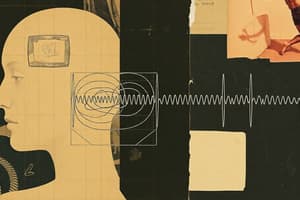Podcast
Questions and Answers
Which nerve conduction study finding is most indicative of demyelinating neuropathy?
Which nerve conduction study finding is most indicative of demyelinating neuropathy?
- Slowed conduction velocities in upper limb segments
- Prolonged distal latencies
- Conduction block in a number of sites (correct)
- Preserved motor amplitudes in hands
What is the significant difference in F-wave latency between the arms and legs in the patient described?
What is the significant difference in F-wave latency between the arms and legs in the patient described?
- Prolonged F-wave latencies in both arms and legs
- Absent F-waves in arms and legs
- Normal F-wave latencies in arms, absent in legs
- Prolonged F-wave latencies in arms, normal in legs (correct)
What distinguishes needle electromyography from nerve conduction studies?
What distinguishes needle electromyography from nerve conduction studies?
- Concentric electrode configuration
- Muscle tested at rest only
- Assessment of sensory amplitudes
- Disposable, single-use needle electrodes (correct)
What is the characteristic sensory finding in the patient with demyelinating neuropathy?
What is the characteristic sensory finding in the patient with demyelinating neuropathy?
What is the most likely reason for reduced reflexes in the arms of the patient with demyelinating neuropathy?
What is the most likely reason for reduced reflexes in the arms of the patient with demyelinating neuropathy?
Which of the following is not a parameter monitored in an ECG?
Which of the following is not a parameter monitored in an ECG?
What is the primary role of EEG in neuroimaging?
What is the primary role of EEG in neuroimaging?
What does an abnormal Q wave in an ECG indicate?
What does an abnormal Q wave in an ECG indicate?
In what conditions can EEG be used for diagnosis?
In what conditions can EEG be used for diagnosis?
Which parameter reflects the summation of synchronous postsynaptic potentials in EEG?
Which parameter reflects the summation of synchronous postsynaptic potentials in EEG?
What is the unit used to measure small electrical signals in EEG recordings?
What is the unit used to measure small electrical signals in EEG recordings?
What is the bandwidth range for ECG signals according to the text?
What is the bandwidth range for ECG signals according to the text?
Which of the following is NOT mentioned as a typical application of ECG in the text?
Which of the following is NOT mentioned as a typical application of ECG in the text?
What is the main source of largest measurement error in ECG according to the text?
What is the main source of largest measurement error in ECG according to the text?
Which leads are part of the Einthoven leads in ECG measurement?
Which leads are part of the Einthoven leads in ECG measurement?
What does the projection of the electric dipole vector represent in ECG readings?
What does the projection of the electric dipole vector represent in ECG readings?
In which plane are the transverse plane leads V1-V6 located?
In which plane are the transverse plane leads V1-V6 located?
Which part of the heart will act as a pacemaker if both the SA node and AV node are not working?
Which part of the heart will act as a pacemaker if both the SA node and AV node are not working?
What is the main electrical event responsible for producing the T wave in a normal heart cycle?
What is the main electrical event responsible for producing the T wave in a normal heart cycle?
Which part of the heart has autorhythmic cells that contract regularly without external stimulation?
Which part of the heart has autorhythmic cells that contract regularly without external stimulation?
What produces the P wave on an ECG recording?
What produces the P wave on an ECG recording?
What is the rate of the AV node serving as a pacemaker in a healthy heart?
What is the rate of the AV node serving as a pacemaker in a healthy heart?
What does an ECG measure?
What does an ECG measure?
Which type of abnormality may be signaled by any spontaneous activity in the muscle?
Which type of abnormality may be signaled by any spontaneous activity in the muscle?
What distinguishes between nerve and muscle disease during electromyography?
What distinguishes between nerve and muscle disease during electromyography?
In electromyography, what pattern is indicative of a myopathic condition?
In electromyography, what pattern is indicative of a myopathic condition?
Which condition is associated with increased early recruitment in motor unit activity?
Which condition is associated with increased early recruitment in motor unit activity?
What is the significance of reduced motor unit potential amplitude in an EMG study?
What is the significance of reduced motor unit potential amplitude in an EMG study?
When fibrillation is absent in an EMG study, what type of process is less likely to be implicated?
When fibrillation is absent in an EMG study, what type of process is less likely to be implicated?
Flashcards are hidden until you start studying




